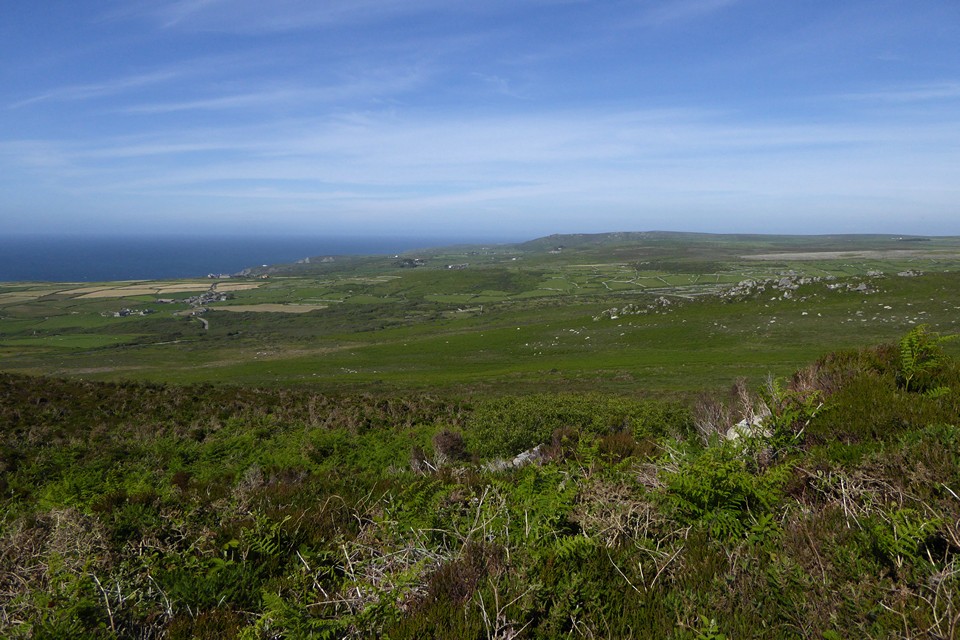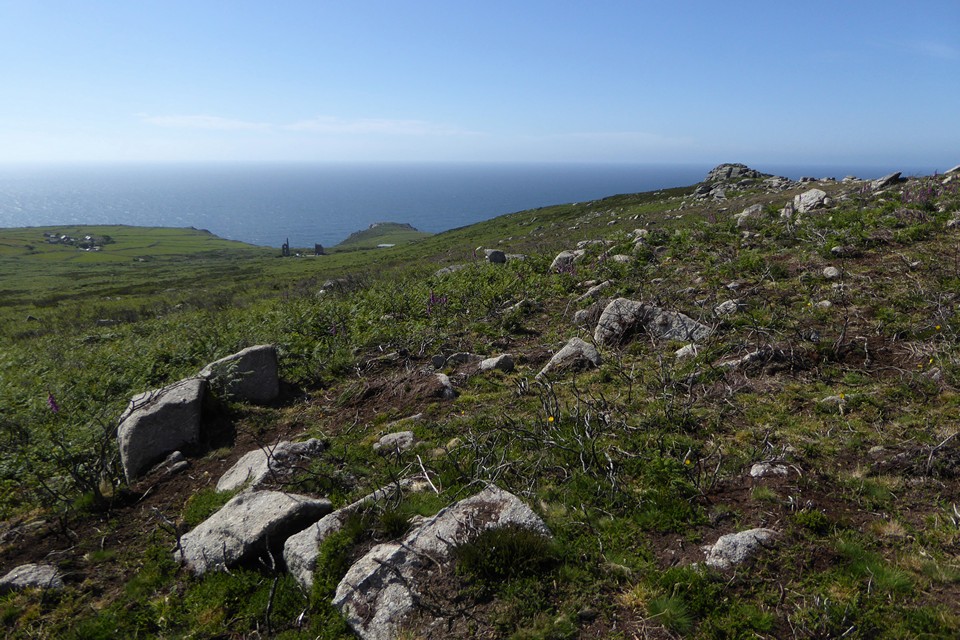




Looking west. The stone is aligned north-east/south-west.
Via Facebook, report and images of damage (presumably fire) at the Cnoc An Tursa. :-(
facebook.com/photo?fbid=386260970177129&set=pcb.386261190177107



The most angular side of the stone.

The stone in its setting, with the high dunes rising on the right.

Landscape context – Godrevy barrow is on top of the prominent headland, left of centre. From Gwithian beach.
I read about this stone in a little book of Penwith monuments I bought a few years ago. Visited 19 June 2021 at the end of a very pleasant beach and cliffs walk from Godrevy Sandshifter to Hayle Towans.
After leaving the coast, we head past Phillack Church and the Bucket of Blood to the point where the road bends sharply south-east. From here, a path heads north-east then north through a scrubby wood and out onto the dunes. The stone is reasonably easy to find, next to a fence separating the open dunes from a house and garden. It’s a nicely tapering 7 foot+ granite monolith, partially covered in hairy lichen.
Looking at the angular edges, my feeling is that it’s more likely to be medieval or post-medieval than prehistoric, although its tall height would be unusual for a boundary stone of that type. There are other boundary stones nearby, none of which come close to the height of this one. The Cornwall & Scilly HER says:
Boundary stone. A tall block of granite, about 7 foot above ground, about 1 foot in section, tapering to a point. Possibly a re-used menhir. The stone marks the bounds of Phillack Towans and Kernick Towans and is indicated on the 1842 Tithe Map. Its height, shape and tapering form suggest an early medieval or prehistoric origin, if not always in this location, certainly here for some time.
After a bit of wandering about in the towering dunes, the sky takes a turn for black and the sunshine of earlier is replaced by a swift rain front, so we beat a hasty retreat back to Hayle before the soaking arrives.

Extensive views north-east towards Zennor Hill, with many prehistoric field systems still in use.


A circular arrangement of stones, which may be hut circle footings.

Looking towards the flat-topped Bosigran Castle cliff fort.

An area of burning on the southwestern side of the ridge has revealed lots of stone, some upright and some apparently in linear arrangements, although it’s very hard to see if anything here is the result of human activity.



More landscape context, from the north. Ding Dong mine on the skyline, the well is hidden from the south by the tall vegetation.

Granite slab or block in the pool. Note quartz vein (and tadpole).


First sight of the well, when approaching upstream from the south-west, with Carn Galver on the skyline.


Stone circle arc. Looking south-west towards Deveral Common (topped with numerous barrows), Boswens Croft (standing stone) and Chûn Castle.
This one has been on the list for a few years. It’s been a bit lost over the years, but is now kept clear and is used in an annual “dolly dunking” ceremony.
We’re quite a way into our walk from St Just (18 June 2021), taking in Tregeseal stone circle, Kenidjack Common, Boswens Croft, Chun Quoit and Castle and a rare revisit to Men-an-Tol.
From the latter, a path heads south-east, slowly descending into a shallow valley. In other years, this area is a bog and we’re very fortunate that it’s dry underfoot for us today. I only have the vaguest idea where the well is, but I figure that when we reach the stream we can just head north-east and eventually we’ll find it.
The further we get upstream the boggier it gets, although it’s still perfectly passable today. The vegetation also gets higher, blocking sections of stream bank from easy exploration so that looking for a well-head becomes harder.
We press on, and we’re rewarded by the sight of some granite slabs protruding from the bank across a small pool – we’re here! It’s a lovely spot, the relative low-level compared to the rising moors giving a feeling of seclusion and peace. There are tadpoles swimming about in the pool, which is quite deep, and lovely and cool to a hand (we don’t sample the water’s healing properties!).
Really pleased to have found this and to come on such a lovely day. From here we head north towards the Four Parish Stone, which is probably an easier place to come here from once you know where you’re going. Then it’s up to Nine Maidens, our place of pilgrimage above all others.